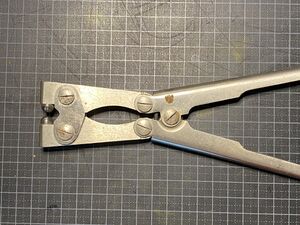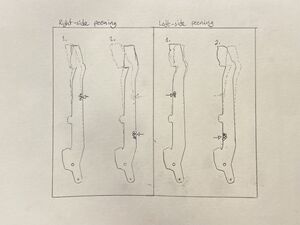Specialized Typewriter Tools
Contents
Introduction
Like with many other types of repairmen, typewriter repairmen were often provided by manufacturers with specialized tools to complete specific tasks or make certain tasks easier. Here, we will attempt to showcase the many different kinds of tools and their general uses.
Typebar Tools
Key Tools
Old glass-keyed typewriters would often have their key inserts or even glass covers damaged or stained. Tools existed to promote the usability and longevity of these parts, and often involved replacement of these parts.
Peening Pliers
A pair of peening pliers are a set of very strong pliers made to "pinch" metal. The "mouth" of the plier usually has two rounded tips that points against each other. There are other kinds of pliers for other purposes that can also serve as a peening plier, but proper peening pliers are better as they are designed to allow for more squeezing power.
Peening metal is a process where you pinch metal to push it outwards to the sides from where you pinch it. The picture below demonstrates the use of a peening plier on a type arm. Inside each individual frame, the same type arm has been drawn the outlines of (one unique arm in the left frame, another unique one in the right). The striped lines are where the typearm trace draws on the drawing marked 1 after only peening it on the upper part of the arm, and the drawing marked 2 after peening it also lower on the arm as signified with the arrow. On the left frame, the type arm has been peened on the right side of the arm, and on the right frame, the opposite. Again; note the arrows and dots indicating 4-5 peening pinches per spot.
Important note: The dotted lines in the drawing is the actual result of peening the metal 4-5 times per step. Particularly for a type arm this is an extreme correction, one you are not likely to have to do to the same degree. This is only done here for the sake of clearly demonstrating which direction metal bends when you peen a certain side. If you want to do peening corrections, make sure you only pinch 1-2 times and then properly test the piece you bent back into the machine to see if that is enough. It is impossible to undo a peening, and you risk having to keep doing counter-adjustments if you go to far, which will only farther distort the metal. Be patient and work gradually.
Special Wrenches
IBM "Semi-Proprietary" Tools
These tools are not proprietary tools, rather uncommon ones used by IBM. They are included here because there is a good chance that they are not included in many tool sets, and can sometimes be hard to identify.
Bristol Spline Wrenches
IBM Standards use Bristol Wrenches or Spline Wrenches on many of the set screws. These can be found on the pulley system for the power roller and on the platen knobs.
IBM Proprietary Tools
These tools are special to only IBM Machines.
Selectric Manual Cycle Tool
The IBM Selectric has a unique tool used for manually cycling the machine while it is off. This tool usually consists of a handle on one end with a left hand #6 screw on the other. It is designed so that it tightens while turning left and loosens when turning eight, which is the opposite of normal screws. These threads are somewhat small, so use caution when manually cycling the machine or you may shear off the thread.
Selectric Manual Cycle Tool Extender
This tool is used specifically in tandem with the Selectric Manual Cycle Tool to allow for manual cycling of the IBM Memory Writer 50, 100, and IBM Composer typewriters. The right side of the operational shaft is right in between the memory bank and power supply of the Memory Writer, and a regular manual cycling tool cannot reach in deep enough to screw into it. The extender is basically a rod with a male left hand thread on one end and a female left hand thread at the other. To use it you simply screw your manual cycle tool into the female end, and then the male end of the extender into the female end of the operational shaft on the machine. It is used just like a Selectric Manual Cycle Tool.

